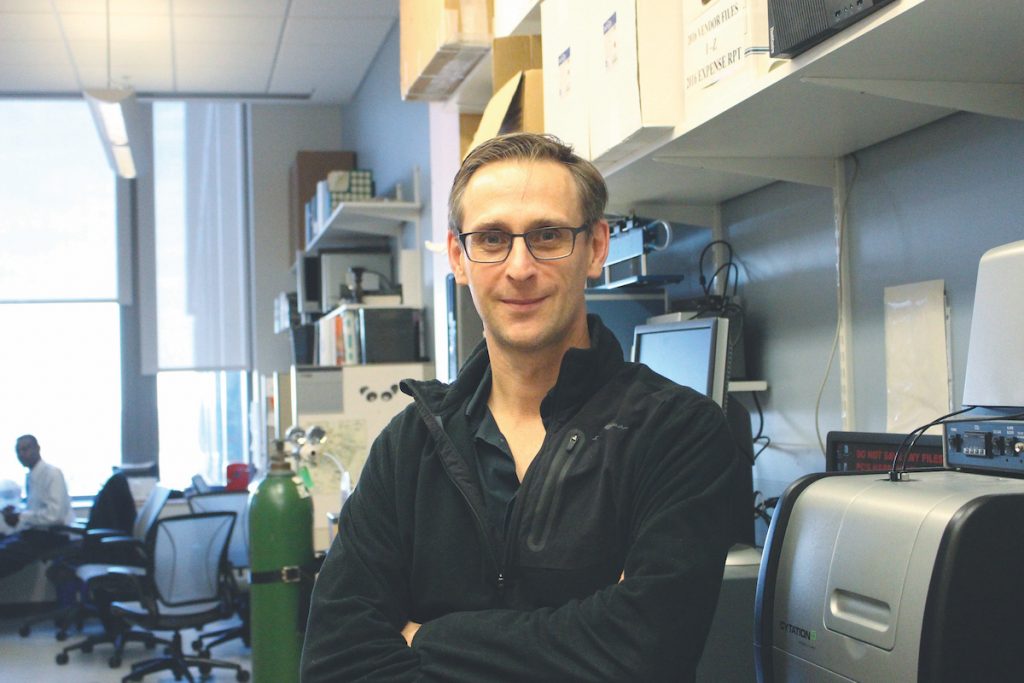While cigarette smoking has declined among adults in the United States, use of electronic cigarettes is driving increases in tobacco product use among young people. The number of middle and high school students using e-cigarettes grew by 1.7 million in just one year to 5.3 million users in 2019, according to the Centers for Disease Control and Prevention.

Researchers at UNC Lineberger have led studies to understand the potential long-term health effects of these emerging tobacco products and seek effective ways to communicate these risks, especially for young adults.
“We’re finding evidence that people who use vaping products are at risk for long-term lung diseases; I think that’s the bigger consequence,” said UNC Lineberger’s Robert Tarran, PhD. He has led work in the laboratory to find that vaping can injure the lungs and lead to changes seen in smokers with emphysema.
Tarran explained that lung cancer and other diseases can impact people after decades of tobacco use. Their experiments tried to identify the biological changes needed to help them predict these longer-term effects.
Vaping and the effect on the lungs
In a study published earlier this year, Tarran and his colleagues found high levels of proteases in the lungs of people who use vaping products. Proteases are “molecular scissors” that cut proteins, and in high quantities, they can cause degradation to surfaces of tiny air sacs in the lungs.
“Vaping has a measurable biological effect on the lungs,” Tarran said.
In addition, Tarran said federal officials are concerned about recent vaping-related deaths, known as EVALI, or e-cigarette-associated lung injury. Federal officials are tracking and studying increasing numbers of vaping-associated deaths around the country. The CDC identified a chemical in lung fluid samples of 29 cases: vitamin E acetate. Tarran has additional questions about EVALI risks.
“Are all e-cigarette users at risk for EVALI?” he said.
Tarran has led a study to dissect the chemicals in vaping products. Out of nearly 150 different e-cigarette products, they found many different chemicals. The more ingredients in the products, the greater the toxicity. That’s a problem, Tarran said. “It’s not just water vapor.”
The products contained not only nicotine, but a chemical that acts as a “vehicle” for both nicotine and THC, the active ingredient in marijuana. They also found flavors and many different flavor chemicals.
“Nicotine is not safe,” he added. “It’s nicotine that’s driving protease release in the lungs, and it will also affect alveolar cells in the lungs and cause inflammation. If you take nicotine as a developing adult, as a teenager, it can lower the threshold of addiction later on in life.”
UNC Lineberger vaping research
E-cigarette flavors and youth

Other UNC Lineberger researchers are working to understand some of the marketing practices that could be drawing teens and adolescents to e-cigarettes. In a review of 51 different research studies, researchers led by UNC Lineberger’s Adam Goldstein, MD, MPH, found consistent evidence that non-menthol flavors for e-cigarettes attracted young adults to use these products.
Most e-cigarettes include at least one of about 7,000 flavors available for purchase, such as blueberry cheesecake, mango, cinnamon, sweet milk and lemon crumble cake.
“Given the fact that nicotine is highly addictive and can affect brain development, and the clear findings that the impact of flavors on youth is strong and consistent, we believe that banning non-menthol flavors in e-cigarettes will help reduce the epidemic of youth e-cigarette use,” Goldstein said.
Youth access to e-cigarettes online
UNC Lineberger’s Rebecca Williams, PhD, MHS, is studying access by teens and adolescents to e-cigarettes and other tobacco products online. She’s uncovered ways that the tobacco industry has gotten around government oversight, particularly as it pertains to sales to minors.
Measuring effectiveness of tobacco preventions ads
Researchers at UNC Lineberger are also working to understand the most effective ways to communicate with young adults about the health effects of tobacco products, including e-cigarettes.
Just this year, the National Cancer Institute awarded a three-year, $1.4 million grant to UNC Lineberger’s Seth Noar, PhD, to develop metrics that will help them measure the effectiveness of tobacco prevention advertisements targeted to adolescents.
Existing metrics to gauge the impact of ads were developed with adult smokers in mind, the researchers report. They were also developed before the advent of e-cigarettes and vaping.
“The project will be successful if it develops a better understanding that helps the FDA and others select more effective ads for their tobacco prevention campaigns,” Noar said.
Prioritizing e-cigarette studies

Another researcher, UNC Lineberger’s Kurt Ribisl, PhD, the Jo Anne Earp Distinguished Professor and chair of health behavior at the UNC Gillings School of Global Health, has been named one of the most prolific e-cigarette scientists by an independent analysis.
The analysis was conducted by researchers at the Rutgers Center for Tobacco Studies and Rutgers Robert Wood Johnson Medical School, and found UNC-Chapel Hill to be the third most prolific producer of scientific publications about e-cigarettes.
“We have prioritized conducting e-cigarette studies at UNC since shortly after they were introduced in the U.S.,” Ribisl said.
